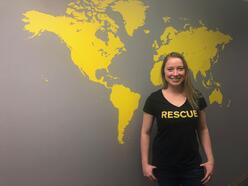
Meet Claire Branstetter, a Resettlement & Placement Caseworker at the IRC in Kansas. She joined the IRC in early 2019, but has been working alongside refugees and immigrants for many years.
What first sparked your interest in refugee resettlement and the International Rescue Committee?
The summer before I graduated from KU I had an internship in Wichita where I met a family of asylum seekers. Through the course of getting to know them and their immigration story I developed a deep appreciation for immigrants and was humbled by their experience. I wanted to learn more about immigration in Wichita. The next semester, for my capstone research project I researched refugee resettlement in Wichita. Initially I wanted to focus on asylum seekers, but there isn’t much information out there. Through the project I discovered that there were two refugee resettlement agencies in Wichita. That was the first time I had heard about the IRC. I fell in love with refugee work after that project, but I thought I wanted to go into the research side of immigration and policy development. After college, I lived in DC for a while and realized I hated being in front of a computer and working on excel spreadsheets all day. I discovered I really wanted to work with people. I saw an internship position open at the IRC in Wichita and applied. IRC asked if I would be interested in applying for a full-time position rather than the internship. Things just seemed to fall into place very neatly and I was able to move back to Wichita and start working here.
Briefly describe what you do all day.
Hmmm…I problem solve and plan and then re-do all of my plans. I also like to tell people that I teach people how to live in the US for a living. I’m part teacher, part accountant, part chauffer, part …. Let’s just say I do a lot of different activities. No two days look the same.
What is your favorite thing to teach newly arrived refugees?
My favorite thing I’ve ever done was how to teach someone how to use the ice maker in their fridge. But the most important things I teach are how to call 911, how to lock the doors, and how to pay the rent.
Do you have any specific memories or interactions with clients that stand out in your mind?
I remember the first time an older woman from the Democratic Republic of Congo saw an aquarium at the leasing office of her apartment complex. She kept staring at it like “what is that.” Finally, she looks over at her niece and asks “chakula?” which means food In Swahili. The niece laughed and finally said no. The woman found it so foreign to keep fish in a tank just to look at them and not to eat, like why would you not eat them?
I also love airport pick-ups. It’s so much fun to greet people in their first moments in the US and often times their seeing family members for the first time in years.
One time I was with a newly arrived family and we were shopping at Dillons. The family I was with ran into another family who were friends from the Congo and hadn’t seen each other in 10 years. They didn’t realize they were both here in Wichita. They had a very joyous reunion in the checkout line of Dillons.
How does the resettlement team collaborate with other teams at the IRC in Kansas?
Constant coordination is always important—when clients come to us with needs, they don’t necessarily know who they need to go to. So being able to refer clients to other staff who are better suited to assist with a particular need is helpful. Working with other programs to understand their funding so that we can maximize spending on each of our programs is also crucial.
What three words best describe you?
Driven. Flexible. Creative.
What is your favorite thing to do in the Wichita area?
I like to find new places to eat. My favorite place to eat is the Wine Dive.
Advice for others about refugees and immigrants
Don’t be afraid to put yourself out there to meet and talk to people. Interacting with your neighbors from different backgrounds is so important and it’s something I would encourage people to do more of.